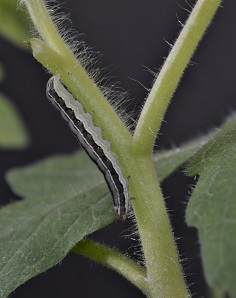ABSTRACTStudents identify, measure, categorize, and summarize different animal behaviors (i.e., bold vs. shy response to identical stimuli) using individual lepidopteran larvae and test correlative relationships between behaviors. Students then use these herbivores to examine leaf consumption in an environment with high predation risk. The experiment is suitable for the exercise of hypothesis generation and carry-over to subsequent experiments with the same cohort of herbivores (e.g., oviposition studies). The experiment generally takes two class periods separated by >48 hours to complete. Activities include group discussion and hypothesis generation, animal behavior assays, herbivory studies, and performing regression analyses. AUTHORSBrian Connolly Biology Department, Eastern Michigan University. 441 Mark Jefferson Science Complex, Ypsilanti, MI 48197 CLASS TIMEBehavioral trials and the setup for the herbivory experiment can be completed in a three-hour lab period. Measuring the completion of the herbivory trial requires ~1 hour of class time >48 hours after the herbivory trial has been completed. I typically spend some in-class time (~1 hour) immediately following conclusion of the herbivory trial helping students enter data and conducting data analysis. I also include 2-3 hours of lab time over the following couple weeks to workshop data analysis or report writing problems. OUTSIDE OF CLASS TIMEI structure this assignment as a group research project requiring students to generate a short, well-written abstract of the study (~300-350 words) with at least one figure appended after the abstract. Student groups that perform well on this assignment typically spend 4 hours outside class time analyzing their data, drafting their abstracts, and preparing their figures. I also encourage student groups to meet with me outside class time at least once for ~1 hour to check progress, help one-on-one with analysis, and help structure writing. STUDENT PRODUCTSStudents generate a short abstract-like report that summarizes 1) the background, rationale, and questions that build towards testing linkages between animal behavior and herbivory, 2) their methods, 3) and the results and a brief discussion of those results in a conclusions section. The assignment also requires them to submit the citation of one peer-reviewed manuscript that explores similar research questions and asks students to include a figure summarizing their results. SETTINGThis experiment is predominantly an in-class experiment that can be completed with materials readily available from biological teaching supply stores. However, add-ons to this experiment can include field components. For example, if instructors prefer to use wild-caught organisms, trips to the field can be made to capture wild adult Pieris rapae or Manduca sexta (or other lepidopterans) for rearing and egg laying at the laboratory. COURSE CONTEXTThis experiment has been performed in an upper-division, writing-intensive ecology laboratory courses with 12-15 students. A simplified version of this lab examining only relationships between insect behavioral assessments was conducted in introductory biology labs for biology majors. INSTITUTIONThis activity was originally taught at a 4-year institution with a significant proportion of class instruction focused on undergraduate education. Thesis and non-thesis Masters degrees in Biology are conferred at this institution, but this lab has not been trialed at the graduate level yet. TRANSFERABILITYThis activity is extremely flexible and can be run simultaneously across multiple lab sections. If multiple lab sections test similar hypotheses, data could be pooled to generate strong power for detecting trends. This lab in not limited by geographical considerations save that the shipping of the live specimens may be restricted to certain states or provinces. Pieris rapae and Manduca sexta are lepidopterans found widely in North America and are an important pest on cruciferous and solanaceous crops. These species can be readily found in many urban, agricultural, and rural locations and frequently found in and around community gardens. DOWNLOADSDescription of other Resource Files:
ACKNOWLEDGMENTSI would like to acknowledge J. Orrock for discussions that inspired this lab and J. Connolly for logistical support during writing. I would like to thank E. Grman, U. Reinhardt, and the Eastern Michigan University [EMU] BIO311W students for trialing the lab in their sections and proposing revisions. Funding supporting the execution and writing of this work was provided by USDA-NIFA (award#2014-02074 & #2021-67019-33427) and the EMU Biology Department. CITATIONBrian Connolly. 10 August 2021, posting date. The very hungry (and bold) caterpillar - A classroom experiment testing relationships between animal behavior and herbivory.Teaching Issues and Experiments in Ecology, Vol. 17: Experiment #1 [online]. https://tiee.esa.org/vol/v17/experiments/connolly/abstract.html |

Generalist lepidopteran Spodoptera exigua caterpillar on a full-grown tomato (Image by B. Connolly) full size image |
<top> | |